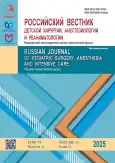Трансанальное эндоректальное низведение кишки у детей с болезнью Гиршпрунга: опыт одного центра за 15 лет
- Авторы: Говорухина О.А.1
-
Учреждения:
- Республиканский научно-практический центр детской хирургии
- Выпуск: Том 15, № 2 (2025)
- Страницы: 155-162
- Раздел: Оригинальные исследования
- URL: https://journal-vniispk.ru/2219-4061/article/view/312997
- DOI: https://doi.org/10.17816/psaic1898
- EDN: https://elibrary.ru/HEKJQG
- ID: 312997
Цитировать
Полный текст
Аннотация
Обоснование. Болезнь Гиршпрунга — один из сложных и тяжелых врожденных пороков развития. Выбор метода хирургического лечения определяется многообразием форм, клинических проявлений заболевания. Метод трансанального эндоректального низведения кишки является наиболее перспективным в настоящее время. Наибольшую сложность представляет лечение осложнений, таких как Гиршпрунг-ассоциированный энтероколит, стеноз колоанального анастомоза. Внедрение новых методов выполнения оперативного вмешательства позволяет уменьшить количество послеоперационных осложнений и улучшить результаты лечения пациентов с болезнью Гиршпрунга.
Цель — улучшение результатов хирургического лечения пациентов с болезнью Гиршпрунга на основании анализа результатов операций эндоректального низведения кишки в собственной модификации и профилактического лечения возможных осложнений.
Материалы и методы. Произведен анализ хирургического лечения болезни Гиршпрунга методом трансанального эндоректального низведения кишки с 2010 по 2024 г. С 2015 г. при выполнении низведения после эндоректальной диссекции прямой кишки в подслизистом слое применялась модификация метода — иссечение мышечного цилиндра по задней стенке анального канала. Проведены необходимые морфологические и рентгенологические исследования. Статистическую обработку полученных результатов проводили с применением пакета прикладных программ Statistica (Version 10-Index, StatSoft Inc.).
Результаты. За последние 15 лет, с 2010 по 2024 г., в Республиканском научно-практическом центре детской хирургии было прооперировано 112 пациентов с болезнью Гиршпрунга в возрасте до 3 лет, которым было произведено трансанальное эндоректальное низведение кишки. Достигнуто снижение частоты стенозов зоны анастомоза после применения метода иссечения задней мышечной манжеты при выполнении операции трансанального эндоректального низведения кишки (в 2015 г.) с 23,7% (9 случаев из 38 пациентов) в период 2010–2014 гг. до 8,3% (4 случая из 48 пациентов) в период 2015–2019 гг., а в период 2020–2024 гг. — до 3,6% (1 случай из 26 пациентов). Частота возникновения энтероколита постепенно снижалась, составляя 25% (21 случай из 86) в период 2010–2019 гг., а за период 2020–2024 гг. — 14,3% (4 случая из 26 пациентов). Было выявлено, что применение метода трансанального эндоректального низведения кишки с иссечением мышечного цилиндра снизило количество послеоперационных осложнений.
Заключение. Трансанальное эндоректальное низведение кишки с иссечением задней мышечной манжеты у детей с болезнью Гиршпрунга наряду с превентивным лечением потенциальных осложнений можно рассматривать как оптимальный метод хирургического лечения этой патологии.
Полный текст
Открыть статью на сайте журналаОб авторах
Ольга Алексеевна Говорухина
Республиканский научно-практический центр детской хирургии
Автор, ответственный за переписку.
Email: govorukhina@mail.ru
ORCID iD: 0000-0002-1605-7031
SPIN-код: 4656-2568
канд. мед. наук, доцент
Белоруссия, МинскДополнительные файлы









